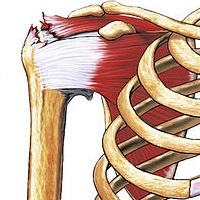
Photo from wikipedia
Objective This paper aims to compare clinical and radiographic features of symptomatic and asymptomatic hips in patients with unilateral femoroacetabular impingement syndrome (FAIS) and to establish a correlation between these… Click to show full abstract
Objective This paper aims to compare clinical and radiographic features of symptomatic and asymptomatic hips in patients with unilateral femoroacetabular impingement syndrome (FAIS) and to establish a correlation between these findings. Methods This is a retrospective study, based on medical records of patients diagnosed with FAIS between January 2014 and April 2017. The patients were assessed clinically as per the International Hip Outcome Tool 33 (iHOT33) questionnaire, visual analogue pain scale, hip rotation, and hip and knee muscular strength. The radiographic evaluation consisted of measurements of the alpha angle, crossover signal, acetabular retroversion index, ischial spine signal, and posterior wall sign. Results A total of 45 patients were included in the study, with mean time from symptom onset to diagnosis of 28.6 months and mean iHOT33 score was 39.9. The mean medial rotation was 20.5° in symptomatic hip and 27.2° in asymptomatic hip ( p < 0.001). The crossover signal was positive on 68.9% of the symptomatic hips and 55.6% of the asymptomatic hips ( p = 0.03). The mean retroversion index was 0.15 in symptomatic hips and 0.11 in asymptomatic hips ( p = 0.02). There was a positive correlation between the total time of symptoms and medial hip rotation reduction ( p = 0.04) and between body mass index (BMI) and medial hip rotation reduction ( p = 0.02). Conclusion When comparing clinical and radiographic features, we observed reduction of medial rotation and increase of acetabular retroversion index in the symptomatic hip, as well as association between the long symptom time and the high BMI with loss of medial rotation of the hips.
Journal Title: Revista Brasileira de Ortopedia
Year Published: 2020
Link to full text (if available)
Share on Social Media: Sign Up to like & get
recommendations!